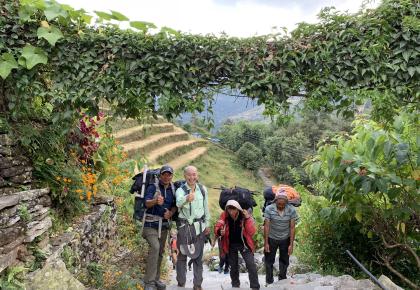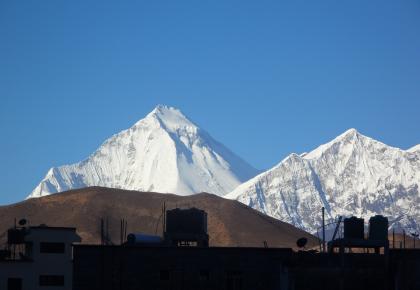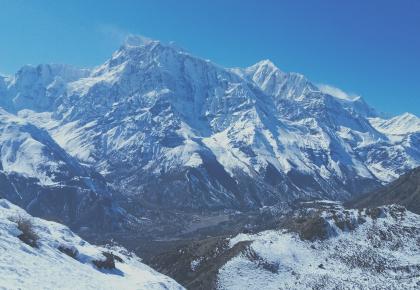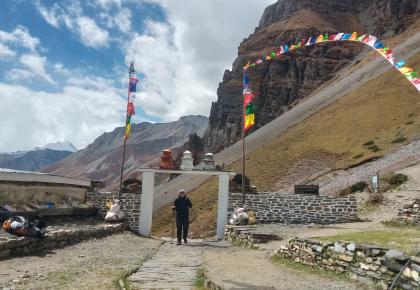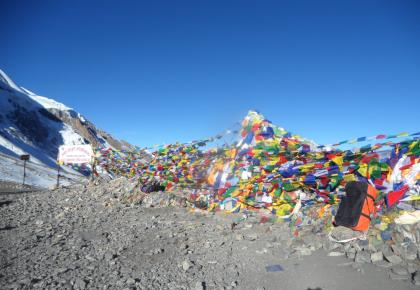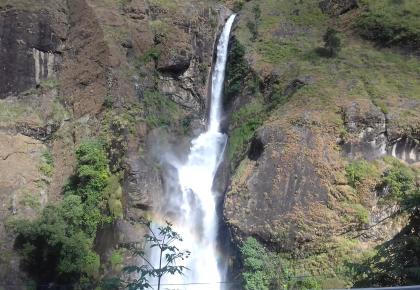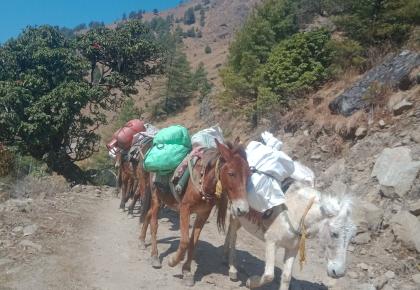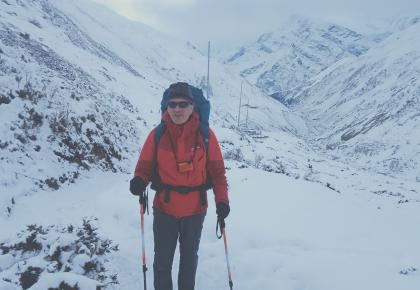Nar Phu Valley Trek With Annapurna Circuit
-
19 Days
Duration
-
5420m
Max Altitude
-
Strenuous
Trip Grade
-
2-14
Group Size
-
SEP to DEC & FEB to JUNE
Best Season
Trip Highlight
- Oppertunities to involve the respected mix Gurung and Magar lifestyles.
- Observe the lower land People’s culture and Customs.
- Surrounded by charming Mt.Annapurna views from Jomsom Upper Pisang.
- Impressive hike through the natural river sound of Marsyandi river.
- Observe the Gurung and Tibetan cultures.
- Glances of the picturesque mountains views from Manang...
- Lovely Mt.Annapuran and Tilico himal view from the Nawal.
- Eye-catching Annapurna II, III, Khansar,Lamjung mountains views..
- Amazing Mt. Dhaulagiri view from the Muktinath.
- Unforable hike with breath-taking mountains view in Thorong La pass.
- Vivid Gangapuran glacier near Manag with Kang La pass.
- Involve the Holy temple of Hindu and buddhist manastries in Muktinath.
- Sightseeing in traditional village Kagbeni and Jhong village.
- Experiences the hike into the Kaligandaki river with views of Mountains.
- Accupy apple kingdom of Marpah and Tuckuche.
- Observe the Tibetan lifes styles in high up Manag and Kaligandki Valley.
- Explore the hidden Nar and Phu Vaeely with their local people'd cultures and life styles
Trip Overview
Nar Phu valley trek with Annapurna Circuit combines the trek in Nar & Phu valley with the Annapurna Circuit. Nar & Phu have been isolated from the outside world for centuries. This is why, the ancient Tibetan lifestyle still thrive in this region of Annapurna. Dhaulagiri and Gangapurna Himals look amazing from somewhere in the middle of the trek. Check out Itinerary for detailed information.
Nar-Phu valley is surrounded by Peru Himalaya to the north, high mountains called Gangla and Gangru to the east, and the Damodar Himalaya to the west. This valley is covered by snow from mid-december till the early February. Around the elevation of 4000 m, thinly shattered pine and fir forests surround both the valleys.
People here are strictly adhered to the Tibetan culture. Large gompas and chortens colored with prayer flags indicate their primary religion as Buddhism. Almost every house is two-storied with flat roofs, where they enter into their house from the roof. The economy is oriented towards agriculture and animal husbandry. Most of their daily commodities are made by themselves. For say, they stitch blankets from the fur of yaks and blue sheeps, they rear. Also, they cultivate in the arable land for food. While, they do import foods from the neighboring villages as what they grow isn’t sufficient for the all the people. Even in terms of uniqueness, they have their own tradition and language. Surprisingly, they love the way they are and are uninterested towards international trading. Trekking in this region of Nepal is simply a unique experience.
As these valleys are close to the Annapurna region of Nepal, many people wonder why this trek isn’t combined with the beauty of gorgeous Annapurna. Because of high demand of this trek, we have come with a new package that sways you towards Nar-Phu valleys along with the Annapurna circuit.
Overview Itinerary
Day 01 - Arrival-Pick up from Nepal airport and transfer to your hotel
Day 02 - Trek preparation and some sight-seeing in Kathmandu valley
Day 03 - Kathmandu to Syange (1050M) Drive 8-9 hours
Day 04 - Trek to Dharapani (1150M) 6-7 hours
Day 05 - Trek to Koto (2630M) 6 hours
Day 06 - Trek to Meta (3540 M) 7-8 hours
Day 07 - Trek to Phu gaun (4260M)-7hours
Day 08 - Phu gaun-acclimatization day
Day 09 - Trek to Nar (4220 M)-6 hours
Day 10 - Nar-Acclimatization day
Day 11 - Nar to Kang La pass (5320M) to Ngawal (3640M) 7-8 hours
Day 12 - Trek to Manang( 3570M) 4hours
Day 13 - Manang –Acclimatise day/short hikes-4 hours
Day 14 - Trek to Yak Kharka 4160M-5 hours
Day 15 - Trek to Throng Phedi 4610m -4 hours
Day 16 - Trek to Muktinath 3830M crossing the Thorong La pass 5420 -7-8:30hours
Day 17 - Drive to Tatopani(Hot spring-1180M
Day 18 - Drive to Pokhara-6hours
Day 19 - Drive to Kathmandu or other activities
Day to Day Itinerary
Kathmandu looks amazing from the window of an airplane: dotted settlements in the middle of lush hills. As your flight descends to the Tribhuvan International Airport in Kathmandu, one of our airport representatives will greet you with a smile and Namaste, and escort you towards your hotel, where you may ease up your jet-lagged body.
However, if you feel like strolling around, then Kathmandu Durbar Square lies within a walking distance, or you may visit the market area of Thamel.
Early in the morning, we set off on a sight-seeing tour to Kathmandu valley, which is a city of wonders. Thousands believe that Kathmandu is an open museum of arts and architecture as more than 10 architectural marvels (7 of which are listed in UNESCO World Heritage Sites) lie within the valley.
However, we cannot accommodate your visit to all these sites in a day. But we promise to take you to those sites, which are best among bests: Pashupatinath Temple (Golden statue), Swayambhunath (the vantage point of Kathmandu valley), Boudhanath Stupa (massive mandala), and Patan Durbar Square (Ancient Royal Palace of Malla Kings built in Newari Style architecture). At the end of the day, you will return to your hotel to stay.
Kathmandu to Syange is a quite long hour drive via Besisahar, which is one of the popular starting points of many treks in the Annapurnas.
Up to Besisahar is a comfortable ride as the road is pitched and the lush valley around propels a sense of contentment to all the spectators. But, as you head on from Besisahar, the trail grows bumpy and windy, eventually oscillating your body time and again, along the gushing Marshyangdi river. Nevertheless, sparse settlements and lush valley make this ride enjoyable. It takes about 9 hours to arrive at Syange, where you make a stay for the night.
The wide Marshyangdi valley gradually narrows as we move higher and higher. With a series of switchbacks until Jagat, you will be able to witness some of the beautiful waterfalls along the trail. You will continue your journey parallel to the lush valley. As you march ahead of Chamje, landslide threatened way to come in front of you to cross. After about 2 hours' walk from there, you will reach a beautiful village named Tal, situated on a plateau next to a beautiful waterfall. The glimpse is no less heavenly.
Having lunch there, you cross a metal bridge over a swiftly flowing river and subsequently follow a marijuana grown field. At the late hours of the day, you arrive Dharapani for an overnight stay.
The trail goes along the same route as Annapurna circuit trek. Walking is quite easy up to Danaque, which takes about 2 hours. It is a big village with a police check-post. As you move ahead, you will cross a river and then the trail diverges into two routes: One follows the jeep road, while other takes you to a steep but picturesque path. The trail is marked with stone steps and as you ascend with your tiresome body, you will encounter a beautiful village of Timang as a source of encouragement for the further climb. It is surrounded by lush green hills and snow-capped mountains. With a few more ascends and descends, you will arrive at Koto, where you spend your night.
Koto cuts off the trail to the Annapurna circuit and leads you towards Meta. Descending to the Marshyangdi, you will cross a bridge and subsequently, the path enters into a Nar Phu valley gorge. After walking about 2 hours by the right of the gorge, you will encounter a few new bridges to cross. Finally, you will arrive at a Dharamshala, which embarks a steep climb to Meta. The path climbs away from the river and at the end of the day, you make an appearance at Meta, which is one of the ex-Khampa settlements.
As you leave Meta, you begin to notice some of the beautiful chortens and whitewashed stupas with golden on top, vibrant with the prayer flags. Snowy peaks begin to show their grandeur along the trail. Following the zigzag way, you will spot wonderful Phu valley intertwined with narrow alleys soon after crossing mighty Nar Phedi monastery.
From here, you will encounter several forts and remnants of the Khampa settlement (Tibetan refugees who settled in the northern region illegally). Minutes before you step into the valley of Phu, a beautiful stupa welcomes your visit. Make sure you visit Tashi Lhakang Gompa, which is one of the oldest monasteries in the world.
By the time you arrive at Phu, you would have gained a very high altitude. So, it is better to acclimatize in the Phu valley, one of the hidden worlds.
This valley is sparsely populated with tiny alleys scattered throughout the plateau. Every alley leads you to some beautiful place to see. Tashi Lhakang Gompa is one of the highlights of this valley. The people here have deep faith in Buddhist culture, which is visible in their lifestyle. They rear yaks for the wool and blue sheep make their appearance at times. All in all, this is a wonderful place.
On this day, you will retrace your steps back along with the same stupa that marked the beginning of Phu valley till Nar Phedi Monastery, from where you diverge your way towards the Nar.
The trail is a fairly easy and short one. You will traverse a suspension bridge hanging over a Lobse river and then follow the snaky trail up until you meet one beautiful stupa lavished with prayer flags to arrive at Nar.
Unlike Phu, this valley is livelier and more vibrant. At day time, you can see women (attired in long Himalayan costume) chewing chat with other women of her kinds. People here are strictly into Buddhism and their culture is highly influenced by that of Tibetans. They are yak herders. They stitch blankets from the yaks’ fur. This valley is completely rural and to expect any modern-day amenities would be foolishness.
It is better to set on a sail early in the morning (if possible, before sunrise) because there is a long way to go today. The trail isn’t the problem, but the altitude is what makes trekking more difficult. Make sure you drink a lot of fluids to alleviate the effects of altitude. While climbing up to the highest point of the trek (Kang La pass), every step feels like running a marathon. The air gets thinner and the temperature grows chilly. With all the vigor when you rise to the top, you can enjoy an amazing view over Annapurna II, Gangapurna, and Tilicho Peak.
Then the trail descends until you arrive at Ngawal. It is a beautiful village to hang on. There are guesthouses, wifi and menus that are pretty extensive.
Just below the Ngawal, the entire route becomes visible. The path slowly descends to the valley and approaches to the river of Marshyangdi. From this point of the trek, Annapurna III and Tilicho Peak are seen above the flat land of the valley. Chortens and Mani walls show their appearance while on the track. When you turn north from the chorten, you can have a glimpse of the Pisang peak shining alone. After about two hours, you arrive at Mugje and subsequently follow a wonderful view of Annapurna II dominating the horizon. After a short walk, Baraka comes into sight, which leads to the Manang after a while.
Manang is indeed a very gratifying destination. Here, the prayer flags adorn the front yard of the houses, and Chortens line up the streets. The houses are made up of stones to prevent the icy wind of the mountains from hitting the families. There are several monasteries to visit, but above all, the splendid panorama of the mountain peaks appears more appealing. Manang is simply earthly heaven for mountains and cultures lover. Plus, many side trips lead off from Manang. You may either hike to the Praken gompa, Gangapurna glacier, Bocho Gompa, or the Ice Lake. Hiking to some higher altitude regions also aids in acclimatization, so we will hike to one of these side trip destinations.
From Manang, continue the trail to the Yak Kharka through the quaint village of Gunsang. Cross a suspension bridge after Gunsang and continue your journey through a big Mani wall and an astounding Chortens. Within a short while, the views of the Gangapurna glacier and other icy ranges begin to show up making the trek more interesting to walk along. Then, through the high pastures, will arrive at the Yak Kharka. Don’t head up to the Churi Ledar unless you are fine with the altitude at Yak Kharka.
Leaving Yak Kharka (translates to the Yak pastures), the trail proceeds along the ascending track and crosses a suspension bridge across the river. Then, a wooden bridge drains the pathway to the slippery landslide area, which is indeed a dangerous pathway. Follow the signposts leading to the Thorong Phedi, but be careful of the falling stones. The final suspension bridge, leading to the Thorong Phedi, offers some of the spectacular views of the snowy peaks. For the day, rest in the Thorong Phedi.
Crossing the Thorong La Pass, the highest point of the Annapurna Circuit is probably the most demanding task of the overall trekking. Progressing too quickly can victimize you from the altitude-related complications. Therefore, walk slow and easy. The Mani walls are made even in the higher trekking zones and at Thorong La pass itself, you may see the stones wrapped by the prayer flags. These stones are kept to ward off the altitude spirits. Within a while, descend to the Muktinath Temple, to enjoy the incredible views of the 2 sacred lake, 108 stone taps, and classic architecture.
Today you are driving by sharing Jeep From Muktinath Tatopani ( hot spring) - From Muktinath head towards the Jomsom via one of the two routes: Kagbeni or Jharkot. Through Kagbeni, the trail mostly follows the dirt road. But on the other side, the path is pleasant and offers outstanding views of the landscapes and the mountains. When you arrive at the Jomsom, spare out some time to explore the marketplaces. They are worth strolling around. Then, descend towards the village of Marpha, which is just a couple of Kilometers below. From Marpha, see the views on the eastern side of the trail. They are worth watching. When you arrived in Tatopani (hot spring) then have your swimming dress and head to the naturally created hot spring. It is one of the very famous sport to chill after the Thorong La pass with cold beers or cold drinks. It is situated bank of the marsyandi river.
Today you all are driving to Pokhara saying goodbye to Annapurna trek from Tatopani. It takes 4-5 hours drive by sharing Jeep or bus.You still have chance to hilly region from your Jeep drive.Once when you reach Pokhra the again you have many nice places are waiting for you to look around.Your guide drop you in your hotel and again have rest and loom around the few lake and have a good foof of Nepal.
Today you are driving from Pokhara to Kathmandu by luxurious tourist bus for 6-7 hours. Again you are the time to enjoy your bus journey with views of the hilly region and locals village. Once when you arrived KTM then has rested and goes for walk shopping or some sight seen as your wish.
Includes:
- International and domestic airport transfers on private jeep or bus.
- 3 Night Accommodation in 3 stars hotel with breakfast in Kathmandu.
- 2 Nigh accommodatin in standard hotel in Pokhara.
- Twin-sharing/double bed room in guest house during the trek.
- Private jeep to trek starting point and trek ending point to Kathmandu.
- English speaking, experienced trekking guide- Trained by Nepal government.
- Required trekking permits (Annapurna conservation area fee and TIMS card)
- Porters (2 clients get 1 porter) to carry clients backpack during the trek.
- Farwell dinner in Kathmandu before your departure.
- Duffle bag (only for trek) and free T-short for clients.
Excludes:
- Your international flight tickets fare.
- Nepal visa (you can apply Nepal visa at Tribhuvan international airport easily)
- Lunch and dinner in Kathmandu.
- Beverages such as cold drinks, alcohol drinks.
- Traver insurance to cover the risk and emergency evacuation.
- Your Personal trekking gear and equipment.
- Personal expenses which are not included in package.
- Tips for guide and porters.
FAQ's
Well experienced local guides and proper mountain porters and well management are main rules to make our customers satisfied. Experiences of the two decades in tourism sector managing their trekking plan and others activities properly to make their ’s dream to bring into the reality according to our customer’s interest, time and trekking areas. We focus on suitable, comfortable and safety plans for our valuable guests to experiences doing mainly trekking, climbing and any tours without ant obstacles. Our team always focus on to provides services to meet our guests ‘s targets, destination and aims in the remote areas of the Himalaya with open heart.
We are easy going local company to manage every single plan for our guests according to their interest. What we say is” GUEST IS GOD”. We value the guests first in our business. What we have is experienced staffs to manage every single thing easily in proper way. Well experienced field staff such as Guides and helpers/porters are the main back bone to stand among you to provides best services. “COME AS A GUEST GO AS A FRIEND”.
We spent more than two decades supporting to the local people in remote area of Nepal. We always provide proper local guides for the proper trekking area/routes. All guides are trained by Nepal government with some training of the First aids. All field staffs are selected sincerely to make sure you are in right in high mountains. Friendly Nepal team is coordinating to peoples who are scattering on the all over the world. I hope our two-decade working experiences in mountains and management in tourism sector may help you to explore the Nepal with confident with right people!!!
We can rent or hire, most of the trekking gear in Kathmandu/Nepal such as a four-season sleeping bag, Puffy down jackets, Micro pikes, trekking shoes, and others. we help you to hire or rent all required trekking gear before your trekking.
Hired trekking gears are must to keep safely if rented gears found damaged then you need to pay the same coast of the gear. You should keep certain amount of money to rent trekking gears. Normally, Trekking gears shop keep deposit $ 100 USD for a sleeping bag and a Puffy down jacket. Renting charge per day is approx. USD 1.50.
One of the re-presentative from Friendly Nepal treks come with private bus or car to pick you up from Tribhuvan airport and drop you in your guest house. With your details of the international flight and your full name, they will be standing in front of the arrival gate in Nepal airport.
Easily you can recognize the staff from Friendly Nepal treks with their T-Short and your name in holding bord. we always make you sure you are in right destination.
Tourists easily can apply their Nepali Visa upon the arrival in Tribhuvan Airport. It may take a few 30 minutes because same time a lot of tourists in the same process to obtain the Nepali Visa in Nepal Airport.
What you can do is please fill the all details to apply the Nepali Visa before landing the Tribhuvan Airport. It help you to obtain visa quicker than usual. You should bring passport photo copy and passport size Photo to apply the Nepali visa in the Nepal Airport.
Trekking in Himalayas are mostly remote. In modern days there are many choices of food menu in every guest house in mountains and serve you proper ordered food. You can enjoy with continental breakfast with fresh fruit as well as lunch and dinner with verities of continental American, Nepali, and Indian foods with hot soups. Most of the food in high mountain supply by helicopter or local porter. Mostly in mountain you get Potatoes items, rice Items, Pasta, Pizza items, breads items and proper vegetables.
Dhal Bhat is the well- known food in Nepal that you get everywhere, Food in mountain cook properly by proper experienced cook. Local food is mostly organic and grown in same region. So, you can enjoy your trek with proper food in high Himalaya. We suggest you to have local food which are grown locally by local peoples.
You can leave your non-trekking gears in Kathmandu hotel safely. Every Hotel, they have proper safe store room to keep the non-trekking gears for the Hotel guests.
Hotel provides you TAG/receive to make sure that your non trekking gears or others backpack are stored in certain hotel. You get your stored belonging when you want. You no need to pay any money to store your luggage.
Flexibilities are the main prior for our guests. Just you send us your international flight tickets and passport copy with PP size photo to make all required trekking permit for your booked trek.
If you booked trek for the Everest, Upper Mustang, kanchenjanga, Dolpo region and other remote areas then you should deposit 15 percent ahead of time to manage flight, trekking permits.
1 porter carry 20-25 kg in high Himalaya in trekking. We have weight limit for Porters because they need to carry their backpack too, So, 20 kg per porter is quite limit weight excluding porter bag pack.
Every 2 guests get 1 porter. Porter are main backbone of the trekking. And good supporters.
Mid-winter treks are getting popular in Nepal. And numbers of tourists are increasing in mid-winter. The data of the report of every trekking areas shows that mid-winter trekkers are increasing in good way.
All are related with global warming, and high glaciers are melting unusually. So, number of tourists are trekking in Nepal in mid- winter. However, you need well preparation with right trekking gears to deal with minus temperature.
You get warm and nice hot shower every day if you want. Every guest house they have hot shower service, mostly you get hot shower which runs by electricity or cooking gas.
Per shower, per person cost approx $5 USD. In some trekking region such as Dolpo, Manaslu, Kanchejanga and other remote area them don not have proper hot shower but provide hot buckets water for shower.
You get warm and nice hot shower every day if you want. Every guest house they have hot shower service, mostly you get hot shower which runs by electricity or cooking gas.
Per shower, per person cost approx $5 USD. In some trekking region such as Dolpo, Manaslu, Kanchejanga and other remote area them don not have proper hot shower but provide hot buckets water for shower.
Safe drinking water is most important to make sure you are in good shape in mountain. We suggest you to get normal drinking water from water tap or gest house and use water purify tablets and wait 30 minute to drink.
Filtering the water from the river or water tap is the also best way to get safe drinking water in trekking but you should come with proper filtering water bottle.
Bottled- water also available to drink but we discourage to use bottled-water to keep environment clean.
We value your goal and always give first priority of what you want. So easily you can customize any trekking area according to you interest, time, we are quite flexible to customize your trekking as your request as can as possible.
Written plan in webpage may not work out for you sometime because of your interest and time or you want to extra days somewhere you like. This is most asked question for us and please feel free and we always customize or make any itinerary according to you interest, time.
Best months for the trekking are the September to Mid-January, which is known as Autumn season and mainly most of the trekkers love to trek during the Autumn because of the beautiful weather and clear days and less chance to get heavy snow in high mountain, Autumn coordinate best weather than others season.
During the Autumn season in high mountain weather would be sunny with plus temperature and some snow refreshment over 3000m. charming mountains are shine with stunning glacier with lush forest lower down.
Second best months are the February to mid-June, which is known as spring season. During the Spring season trekkers have opportunities to glance the colourful Rhododendron flowers in the elevation of the below 3000m and others alpine flowers blooms in late spring season. Weather would be little windy with some hailstones in hilly region and some snow refreshment in high mountain.
Number of solo women- trekkers are trekking in mountain and Nepal is the still safe country for the solo trekkers in mountain. Solo women always safe with Friendly Nepal.
Some exercises are important before the hitting the mountain, everyday running for 1 hour for few weeks, jugging, and Gym and stay active and proper food with high carb as well as jumping.
Hiking up and down every day makes your muscle strong and keep fit your body. Move around your body, push up and down, play food ball, volley ball and other game which gives you physical exercises.
Well mental preparation plays main roles to trek in Himalayas. Be positive with mountains, get enough information regarding the coming trek. And Planning well to get ready to climb up and down.
Depend on where you are going to trek, some wherein big town they may have ATM machine to draw the money but most of the trekking places in mountain there are not any ATM, So Credit cards is not worth using in mountain.
Make sure getting enough cash with some contingency budget for the trekking.
It cost you depend how much you spend. Approx $ 20-25 USD is quite enough for additional expenditures. You can buy water, chocolates, coffee and Biscuits and others fancy things.
Minus 10 sleeping bags require from September to November and minus 20 sleeping bags require from early December to mid- January). In case of the weather change in high mountain then you get extra banket in additional cost.
You can charge easily your batteries, cell phone, camera in trekking/mountains. When you are in the mountain region the, every guest house have sollar systems to charge you electric equipment, make sure charging your batteries before the sun go down. At least you get chance to charge your batteries, and other electric equipment.
Note: if weather get change in unusual situation then no any charging in high mountains because of the no sun.
Definitely you get enough boiled or hot water in trekking in the additional cost.In Annapurna, Langtang and Manaslu and mustang, hot water is little cheaper than in Everest , Makalu, Kanchenjang.
It cost you $2 -5 USD per litter for the boil water in trekking.
You should bring passport size photos -4 pieces.
Passport photo copy – 1 Piece.
Your Travel insurance’s Photo copy -1 piece.
Sure, you can extend the trekking days during the trek, just coordinate with guide and company few days ago you decided.
Some people may like to stay somewhere in nice places more days more than written plan or spend more time in KTM or Pokhara or somewhere.
Depend where you are trekking, there are internet services in mountain, If you are trekking in Everest, Annapurna, Langtang, Manaslu and Upper mustang then easily you get internate services in every guesthouses in additional cost.
If you are trekking in far remote areas such as Kanchejanga, Upper Dolpo and Narphu Valleys then internet services are limits.
Risk and Liabilities
- Jomsom to Pokhara flight may delay in case of the weather change.
- Avoid the Altitude sickness hiking slow, wearing warm cloths, drinking enough.
- Make sure having Personal medication for in case of any issue of health.
- Easily any hiker may get altitude sickness from wrong eating, poor gears.
- Hikers may get easily dehydred so drink enough treated water, 3-4 LTRs per
- Always let the guide know in case of feeling sick or anything wrong in mountains.
- If you loss your belonging by negligences, that might be your responsibilities.
- Always come with travel insurance which is must important in remore/mountain.
- Pay attention whilst you are trekking in the gedge of the river, glaciers, high passes.
- Use trekking pole in the edge of the hill and rivers sides.
- Make sure having proper trekking gear before the trek.
- Always keep your valuable dacuments with you.
- High mountain is always risk of altitude, go slow with adequate water.
- Do not throw rubbish anywhere. put in proper zone please.
Sam Ireland
United KingdomAmazing experiences!
We Completed the Nar Phu and Annapurna Circuit in May 2023 with Santa and a friend. I have had past experience with guides trying to dictate a set itinerary and not being very knowledgable about the mountains and culture. Santa definitely deliveres as a guide & is well worth the money. His commitment to safety really helps to build trust & his extensive experience in all regions of Nepal assure you that he will always pick the best route available at the time. He was also very flexible with the itinerary, allowing for adjustments for side treks or due to inclement weather. At the end of the trek, I thought of Santa as a friend, rather than a paid guide & would not hesitate to undertake other treks with him while in Nepal!
Laubi
Excellent Guide!
Nov 2022 • Friends Completed the Nar Phu and Annapurna Circuit in May 2013 with Santa and a friend. I have had past experience with guides trying to dictate a set itinerary and not being very knowledgable about the mountains and culture. Santa definitely deliveres as a guide & is well worth the money. His commitment to safety really helps to build trust & his extensive experience in all regions of Nepal assure you that he will always pick the best route available at the time. He was also very flexible with the itinerary, allowing for adjustments for side treks or due to inclement weather. At the end of the trek, I thought of Santa as a friend, rather than a paid guide & would not hesitate to undertake other treks with him while in Nepal!
Aiman Kassasti
Iceland Fantastic experience! Helped us sort out the best trip we have ever been on!
May 2019 • Friends We were pretty intimidated with figuring out how to plan the Nar Phu Valley and Annapurna circuit trip and Santa was a major help. He helped us settle down in Kathmandu, accommodated for our out of the way itinerary and got us an amazing guide (Dawa Sherpa). We trekked Nar Phu valley with Annapurna circuit and Santa and his group ensured that we we had good support along the way. Also on our way back, there was terrible weather which can result in planes not flying out of Jomsom for days, but Santa somehow managed to get us onto the last flights that were going out that afternoon (Later heard that there were no flights out of Jomsom for two days due to weather). Would absolutely not hesitate to book with Santa for future trips.
Leigh wilson
New ZealandSanta is the best guide in Nepal!!
June 2022 • Friends I have trekked 2022 June in Nar Phu valley and Annapurna circuit with Santa many times over the years and recommended allot of freinds who share my same statement. - he is the best ! Safe knowledgeable and caring I could not recommend him enough. Singles couples groups. He understands what type of trek you want and helps you have a memorable vacation sending porters forward to secure best accommodation even best rooms.
